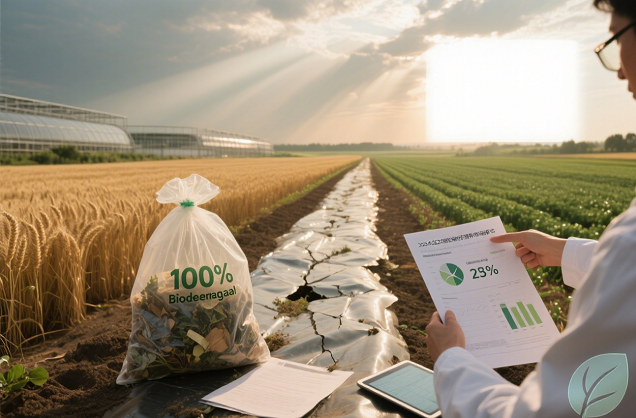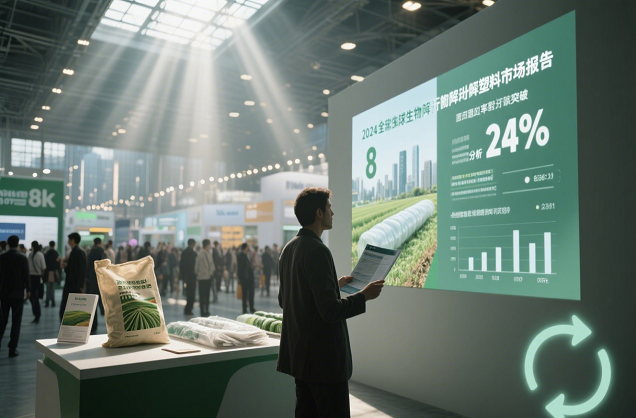Global Biodegradable Plastics Market Report 2024: Key Analysis for Substitution Rate to Cross 25
2024 will be a key turning point in the development of biodegradable plastics. According to the latest market research data, the global biodegradable plastics market size is expected to reach 15.6 billion U.S. dollars, with a high annual growth rate of 21.3%. With the upgrading of the EU SUP Directive, the implementation of China's 14th Five-Year Plan, and the incentives provided by the US IRA, the replacement rate of biodegradable plastics in the traditional plastics market is expected to exceed the 25% mark for the first time. This article analyzes the drivers behind this milestone, regional market differences, and the challenges ahead.

I. Market Size and Growth Forecast
1. Global Market Panoramic Scan
- Total volume data: global production capacity is expected to reach 2.8 million tons in 2024 (180% growth from 2021)
- Regional Distribution:
Asia: 58% (China accounts for 75% of Asia's capacity)
Europe: 24% (Germany, Italy dominate)
North America: 15% (US growing at 30%)
- Category structure:
PLA: 42% market share
PBAT: 33%
Starch-based: 18 percent
Others: 7%
2. Substitution rate exceeded 25% of the four pillars
(1) Policy-enforced substitution: EU will ban disposable PS packaging from 2024, creating 800,000 tons of substitution demand
(2) Cost gap narrowing: PLA and traditional PP price ratio from 3:1 in 2020 to 1.8:1 in 2024
(3) Performance breakthrough: heat-resistant PLA (120 ℃) and flexible PBAT to meet 90% of the packaging needs
(4) Improved recycling system: the number of global industrial composting facilities increased by 400% in five years
II. Analysis of key application areas
1. Packaging industry (62% of total demand)
- Food Packaging: 34% penetration of bio-based film in fresh-cut fruits and vegetables packaging
- Express packaging: Amazon and other e-commerce platforms to promote the use of biodegradable tape increased by 150% annually
- Innovation case: Coca-Cola plant-based bottle labels are 100% PLA film
2. Agriculture (23% share)
- Mulch revolution: China's biodegradable mulch subsidy policy drives 45% annual demand growth
- Technological breakthrough: biodegradable film can be degraded in 3-24 months.
- Cost optimization: the difference between mu cost and traditional PE film is reduced to RMB 15 yuan.
3. Consumer goods (15%)
- Disposable tableware: 40% conversion rate for European and American restaurant chain brands.
- Sanitary products: 300% growth in PBAT fiber adoption for flushable wipes
- 3D printing: PLA threads account for 65% of the consumer-grade market share

III. Analysis of Regional Development Differences
1. Asian market: China leads growth
- Policy-driven: Hainan “plastic ban” upgrade, violators of the maximum fine of 100,000 yuan
- Capacity expansion: Jinfa Science and Technology, Fengyuan Group and other enterprises to add PLA production capacity of 500,000 tons
- Price advantage: China's PBAT price is 25% lower than that of Europe.
2. European market: standards first
- Certification barriers: EN13432 certification costs increased by 15% of the enterprise expenditure
- Recycling system: industrial composting facilities cover 92% of the population
- Innovation hotspot: Germany BASF develops bio-based PBAT (60% renewable raw materials)
3. North American market: policy turnaround
- IRA Act: 30% tax credit for biomaterials companies
- Retail requirements: Walmart requires 30% of packaging to be compostable by 2025
- Technology shortcomings: PLA capacity is heavily dependent on Asian imports

IV. Key Challenges to Replacement Rate Breakthroughs
1. Recycling infrastructure gap
- Dilemma: Only 23% of cities have industrial composting capabilities
- Solution: HolyGrail 2.0 digital watermarking technology to improve sorting efficiency.
2. Consumer Misperceptions
- Common Misconception: 68% of consumers believe “biodegradable = disposable”.
- Educational example: Recoup UK launched a public education campaign on the “Compostable Label”.
3. Long-term durability concerns
- Technology breakthrough: Dow Chemical develops 18-month shelf-life stabilizer
- Test Standard: ISO Releases New Accelerated Aging Test Methods

V. An industrial revolution that crosses the tipping point
The 25% replacement rate of biodegradable plastics by 2024 is not the end of the road, but the beginning of a new material era. With continued technological breakthroughs (PLA modification, PBAT biobased), increased policy efforts (67 countries around the world have implemented plastic restrictions), and rising consumer awareness (ESG purchasing share increasing by 20% annually), this figure is expected to reach 45% by 2029. Companies should focus on this:
Technology reserve: layout of non-food raw materials and intelligent degradation technology
Certification: obtain EN13432/ASTM D6400 certification in advance.
Regional adaptation: Asia focuses on cost, Europe focuses on standards, and North America focuses on policy incentives.
The material revolution led by biodegradable plastics is reshaping the $280 billion global plastics industry. Those companies that have laid out their plans in advance will not only gain market share, but will also occupy a strategic high ground in the sustainable economic transformation.
 For PLA/PBAT biodegradable mat
For PLA/PBAT biodegradable mat
 Price war! PBAT raw material p
Price war! PBAT raw material p
 PBAT degradation speed increas
PBAT degradation speed increas
 From Policy to Practice: Impli
From Policy to Practice: Impli
CONTACT
Add: Room 4006, No.1 Helong Yiheng Road, Baiyun District, Guangzhou City
Tel: +8613450255948
Wechat : +86-13450255948
Fax: +86-13450255948
E-mail: 13450255948@163.com








